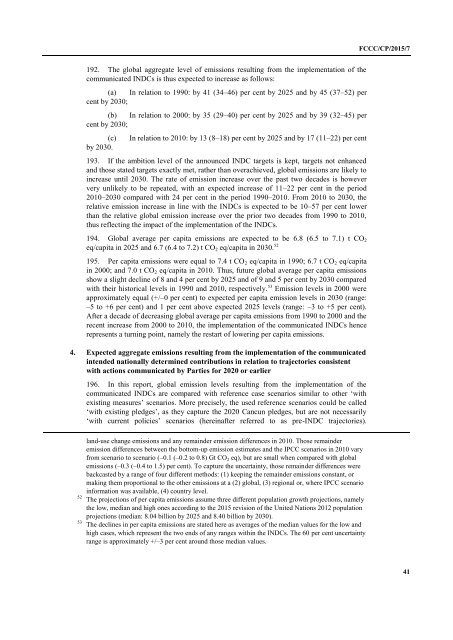FCCC/CP/2015/7
1PYuHQM
1PYuHQM
You also want an ePaper? Increase the reach of your titles
YUMPU automatically turns print PDFs into web optimized ePapers that Google loves.
<strong>FCCC</strong>/<strong>CP</strong>/<strong>2015</strong>/7<br />
192. The global aggregate level of emissions resulting from the implementation of the<br />
communicated INDCs is thus expected to increase as follows:<br />
(a) In relation to 1990: by 41 (34–46) per cent by 2025 and by 45 (37–52) per<br />
cent by 2030;<br />
(b) In relation to 2000: by 35 (29–40) per cent by 2025 and by 39 (32–45) per<br />
cent by 2030;<br />
(c)<br />
by 2030.<br />
In relation to 2010: by 13 (8–18) per cent by 2025 and by 17 (11–22) per cent<br />
193. If the ambition level of the announced INDC targets is kept, targets not enhanced<br />
and those stated targets exactly met, rather than overachieved, global emissions are likely to<br />
increase until 2030. The rate of emission increase over the past two decades is however<br />
very unlikely to be repeated, with an expected increase of 11–22 per cent in the period<br />
2010–2030 compared with 24 per cent in the period 1990–2010. From 2010 to 2030, the<br />
relative emission increase in line with the INDCs is expected to be 10–57 per cent lower<br />
than the relative global emission increase over the prior two decades from 1990 to 2010,<br />
thus reflecting the impact of the implementation of the INDCs.<br />
194. Global average per capita emissions are expected to be 6.8 (6.5 to 7.1) t CO 2<br />
eq/capita in 2025 and 6.7 (6.4 to 7.2) t CO 2 eq/capita in 2030. 52<br />
195. Per capita emissions were equal to 7.4 t CO 2 eq/capita in 1990; 6.7 t CO 2 eq/capita<br />
in 2000; and 7.0 t CO 2 eq/capita in 2010. Thus, future global average per capita emissions<br />
show a slight decline of 8 and 4 per cent by 2025 and of 9 and 5 per cent by 2030 compared<br />
with their historical levels in 1990 and 2010, respectively. 53 Emission levels in 2000 were<br />
approximately equal (+/–0 per cent) to expected per capita emission levels in 2030 (range:<br />
–5 to +6 per cent) and 1 per cent above expected 2025 levels (range: –3 to +5 per cent).<br />
After a decade of decreasing global average per capita emissions from 1990 to 2000 and the<br />
recent increase from 2000 to 2010, the implementation of the communicated INDCs hence<br />
represents a turning point, namely the restart of lowering per capita emissions.<br />
4. Expected aggregate emissions resulting from the implementation of the communicated<br />
intended nationally determined contributions in relation to trajectories consistent<br />
with actions communicated by Parties for 2020 or earlier<br />
196. In this report, global emission levels resulting from the implementation of the<br />
communicated INDCs are compared with reference case scenarios similar to other ‘with<br />
existing measures’ scenarios. More precisely, the used reference scenarios could be called<br />
‘with existing pledges’, as they capture the 2020 Cancun pledges, but are not necessarily<br />
‘with current policies’ scenarios (hereinafter referred to as pre-INDC trajectories).<br />
land-use change emissions and any remainder emission differences in 2010. Those remainder<br />
emission differences between the bottom-up emission estimates and the IPCC scenarios in 2010 vary<br />
from scenario to scenario (–0.1 (–0.2 to 0.8) Gt CO 2 eq), but are small when compared with global<br />
emissions (–0.3 (–0.4 to 1.5) per cent). To capture the uncertainty, those remainder differences were<br />
backcasted by a range of four different methods: (1) keeping the remainder emissions constant, or<br />
making them proportional to the other emissions at a (2) global, (3) regional or, where IPCC scenario<br />
information was available, (4) country level.<br />
52 The projections of per capita emissions assume three different population growth projections, namely<br />
the low, median and high ones according to the <strong>2015</strong> revision of the United Nations 2012 population<br />
projections (median: 8.04 billion by 2025 and 8.40 billion by 2030).<br />
53 The declines in per capita emissions are stated here as averages of the median values for the low and<br />
high cases, which represent the two ends of any ranges within the INDCs. The 60 per cent uncertainty<br />
range is approximately +/–3 per cent around those median values.<br />
41


